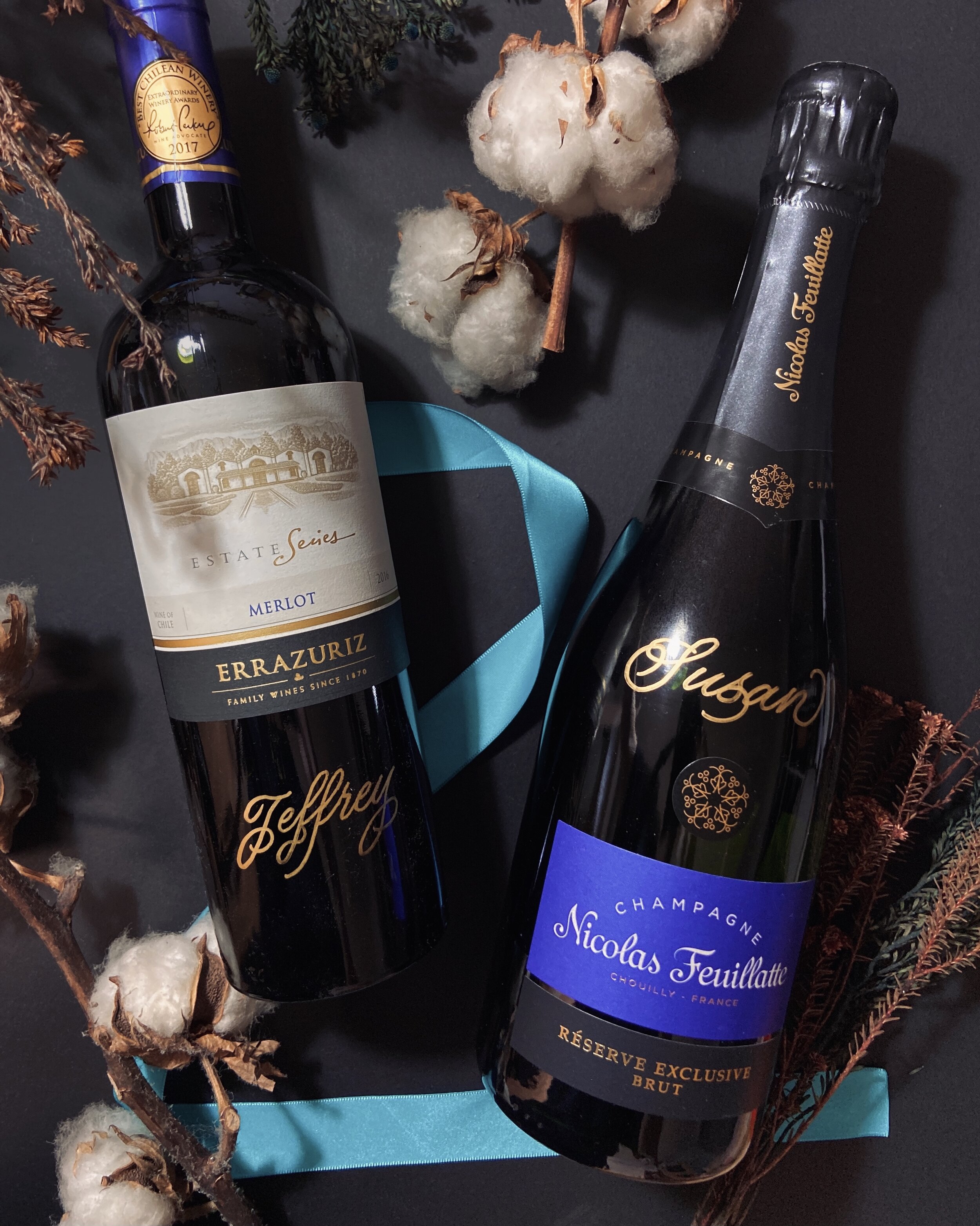


I’ve recently wrapped up a custom calligraphy project with Manulife Singapore, where I was sent 110 bottles of wine and champagne to customise. After sharing images and videos about these, I’ve received several questions about my process, so here’s a list of compiled questions and answers to help you if you ever wanna do something similar!
Process
Before writing, first ensure that the bottles are in room temperature, not chilled. Condensation on the bottle is hard to work with and it’s a definite no go!
Sort all names in alphabetical order and print out the name lists for easy reference. For me, I printed out one name list for Champagne and another name list for Merlot, both lists in alphabetical order with allocated quantity.
I’m using Painty Metallic Gold Marker by Zig. Shake well and test on paper first before writing in case of any ink explosion (we definitely don’t want that!).
Ensure that your writing surface is clean from any dust. When shipped in boxes, they tend to be quite dusty straight from the box! This step helps to prevent any clogging or y’know those bumpy small areas in your ink when dried? Yeah, nasty stuff. Clean yo’ surfaces for smooth application AND finish!
To stay organised, you may also have a separate pen to check off names when you’re done with each bottle. But, I personally skipped this! I think it slows me down a little. (Or, have someone help you out with this step!)
Don’t forget to let your ink dry, don’t touch or accidentally smudge it.
As I’m writing, I line up the bottles in rows of 5 or 10 so it’s easier to count the quantities in total at the end. Once done, double check spelling and the total number of bottles. We wanna ensure that the Client gets all the bottles with everything spelt right with accuracy! Getting sent back bottles with misspelt names equals double the admin, process and work so let’s strive to get everything right first time round!
Don’t forget to photograph your work so that you can add em to your portfolio for future client jobs!
Finally, time to pack! Remember to tape all ends of the boxes both top and bottom to secure in case of damage during transport or shipping. I also label each box at the top for the Client’s easy reference. So for example, if a box contains all names from L to W, I’ll write "L-W” at the top of the box.
You’ve asked some Q’s, here are the A’s! + tips and tricks!
Q1: How do you keep your calligraphy straight?
Thankfully, the Merlot labels are rectangular and that helped to provide a straight reference guide for me. I personally find circle labels or anything curved to be trickier to visualise a straight line!
*Hot tip!* When you’re writing, remember to rotate and tilt the bottle with your non-writing hand in small increments while pivoting the bottom of the bottle against your writing surface. This helps to support your script and writing hand while maintaining good eye-level alignment (ie. no parallax error which causes letters sloping downwards) Here’s a visual example:
Alternatively, you can also use pencils and draw guidelines for yourself prior to writing. Stabilo All Pencil or Glass Marking Pencil (White) would work great for glass surfaces! Or potentially, you may also use a white chalk pencil. If you do go for this step, remember to only rub off the marks with a cloth or tissue only after the initial gold ink has fully dried.
Q2: How do you keep your calligraphy centred?
Great question! This definitely comes with practice and experience. Try to visualise the middle letter to be directly underneath or above the mid-portion of the label. For example, if I’m writing the name “Gabriella”, I can visualise letter “i” as the central letter of the name and this letter should sit at the middle of the bottle. From here, I’ll gauge how far left and right the other letters would go.
*Note: This also depends on the capital letter! For example, a capital G or M is wider in width than a capital I. So do adjust accordingly.
*Hot Tip!*: If you’ve a really long name to write, try air-writing on the bottle first to gauge spacing ie. hover your finger above or on the bottle and practise writing to see if it works first. Once you’ve your eyes fixed on the placement, try it with the marker.
*Hot Tip!*: If you’ve finished writing a name and see that it’s not centred, here are two ways to fix:
If the name is flushed towards the right, add additional flourishes to your first capital letter to extend the front part of the name.
If the name is flushed towards the left, extend the last stroke of your last letter (also known as an exit stroke) to extend the last part of the name.
And if all else fails, read Q3!
Q3: What happens when you misspell? Does the Client provide you with extras?
Wine and champagne aren’t cheap so the Client didn’t provide extras for me, which I totally understand! Usually, for more budget-friendly product materials such as branded notecards or anything paper, I’d ask for anywhere between 10% to 25% additional quantity. But in this case, I didn’t. Anyway, no worries! If you misspell anything, you can quickly remove the ink using rubbing alcohol since the marker is an oil-based one.
*Note: If you’re doing calligraphy engraving, however, there’s no going back! In this case, I’d recommend perhaps adding marking guidelines with the pencils I’ve mentioned above in Q1. Or you can also use a liquid chalk marker to draft your design and engrave directly thereafter as chalk ink can be easily removed afterwards with a damp cloth, leaving you with only the engraved design. For anyone who’s interested, I use Stylo+ by Dremel for engraving!
Q4: Can I use other types of markers?
I’ve tried other markers before finally sticking to Painty Metallic Gold Marker by Zig. I find that this marker gives a really good and bright shine while still being semi-matte. And I love this look! I’m usually very particular with the gold shade too - overly yellow warm gold isn’t my favourite. I prefer a more cool-toned gold. Either way, experiment with other markers and see which you like! I’d definitely stick to oil-based markers instead of any acrylic or water-based markers as oil-based inks are resistant to water and scratches but acrylic or water-based ones may risk smudging or lack in longevity (especially when the customer brings the bottle out after chilling and water condensation hits).
Q5: Do you seal your writing?
I don’t as I’m using oil-based markers! If you’re using acrylic or water-based markers then yes, seal it!
Q6: How long did everything take?
For all 110 bottles, I believe I took 3-4 hours! And 1 hour for packing and unpacking, counting, printing the name list etc. etc. - all the admin things. Oh, btw - 1 painty metallic marker lasted me through the whole thing!
Q7: How did you get this job?
Manulife emailed me via my website! I had other wine engraving and custom inked wine bottles on my website so I believe that’s how they found me. Always remember to photograph your work and share on socials and/or portfolio! If you don’t have any prior bottles to show, don’t let that stop you. Be your own client and buy yourself or a friend one (or some) and treat it like a client job! You can also practise your script in pencil first and once you’re comfortable and confident, try it on the bottle.
That’s all for now! I hope this helps. If you’ve any questions along the way, don’t hesitate to comment your question below or DM me on Instagram and I’ll be sure to answer and help. Thanks for reading and all the best with your wine writing! 🥳️
P.S. If you’re looking to start your calligraphy journey or improve your current skills, feel free to check out my online calligraphy course here!




